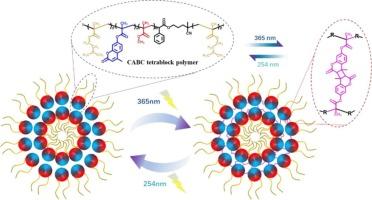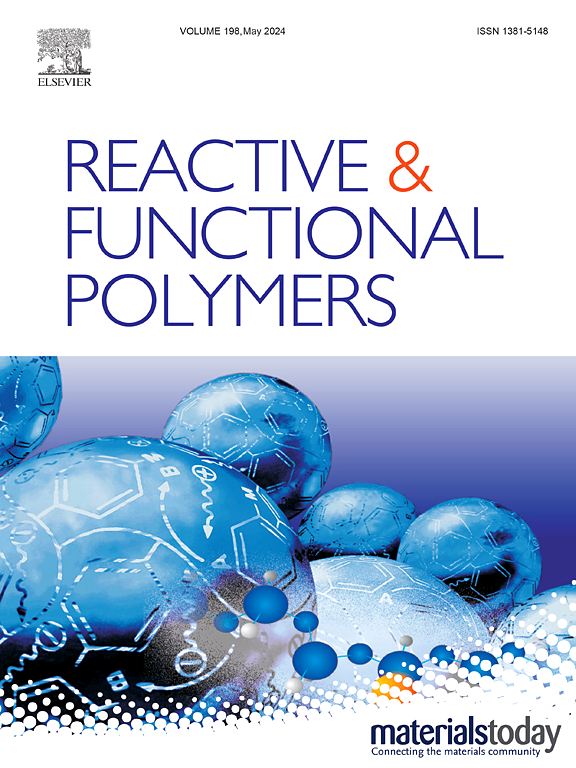二氧化碳和紫外光双响应不对称四嵌段聚合物的简便合成
IF 4.5
3区 工程技术
Q1 CHEMISTRY, APPLIED
引用次数: 0
摘要
本研究报告了基于甲基丙烯酸甲酯(MMA)的有机催化可逆络合介导自由基聚合(RCMP)的二氧化碳/紫外线(UV)光双响应 CABC 型不对称四嵌段聚合物(CABC-ATP)的合成、2-丙烯酸、2-甲基-4-甲基-2-氧代-2H-1-苯并吡喃-7-基酯(CMMA)和甲基丙烯酸 2-(二甲基氨基)乙基酯(DMAEMA)为嵌段单体,通过三个步骤进行有机催化可逆络合介导自由基聚合(RCMP)。得到的 CABC-ATP 具有可控的平均分子量(Mn)和较窄的分子量分布(Mw/Mn = 1.18-1.29)。利用动态光散射和荧光测定法测量了其水动力直径和荧光强度。值得注意的是,实验后囊泡体积从最初测量的 247.6 纳米增加到 285.4 纳米。最初记录的荧光发射强度为 4971,在引入二氧化碳 20 分钟后降至 1412。随后,在接触氮气后,荧光强度恢复到 5199。CABC-ATP 对紫外线的反应行为是由于香豆素基单体交联,导致荧光强度在宏观上发生变化。此外,二氧化碳的刺激促进了叔胺的质子化,从而在微观上导致了囊泡体积的变化。本文章由计算机程序翻译,如有差异,请以英文原文为准。

Facile synthesis of carbon dioxide and UV light dual-responsive asymmetric tetrablock polymers
This work reports the synthesis of CO2/ultraviolet (UV) light dual-responsive CABC-type asymmetric tetrablock polymers (CABC-ATP) based on organocatalyzed reversible complexation-mediated radical polymerization (RCMP) with methyl methacrylate (MMA), 2-Propenoic acid, 2-methyl-4-methyl-2-oxo-2H-1-benzopyran-7-yl ester (CMMA), and 2-(dimethylamino)ethyl methacrylate (DMAEMA) as block monomers by three steps. The obtained CABC-ATP has controllable number average molecular weight (Mn) and narrow molecular weight distribution (Mw/Mn = 1.18–1.29). The hydrodynamic diameter and fluorescence intensity were measured using dynamic light scattering coupled with fluorescence assays. Notably, the vesicle volume increased from an initial measurement of 247.6 nm to 285.4 nm post-experiment. The initial fluorescence emission intensity recorded was 4971, which decreased to 1412 following the introduction of carbon dioxide for 20 min. Subsequently, the fluorescence intensity recovered to 5199 upon nitrogen exposure. The response behavior of CABC-ATP to UV light is due to the cross-linking of coumarin-based monomer, resulting in the change of fluorescence intensity at the macro level. Besides, the protonation of tertiary amine is promoted by the stimulation of CO2, generating of the change of vesicle volume at the micro level.
求助全文
通过发布文献求助,成功后即可免费获取论文全文。
去求助
来源期刊

Reactive & Functional Polymers
工程技术-高分子科学
CiteScore
8.90
自引率
5.90%
发文量
259
审稿时长
27 days
期刊介绍:
Reactive & Functional Polymers provides a forum to disseminate original ideas, concepts and developments in the science and technology of polymers with functional groups, which impart specific chemical reactivity or physical, chemical, structural, biological, and pharmacological functionality. The scope covers organic polymers, acting for instance as reagents, catalysts, templates, ion-exchangers, selective sorbents, chelating or antimicrobial agents, drug carriers, sensors, membranes, and hydrogels. This also includes reactive cross-linkable prepolymers and high-performance thermosetting polymers, natural or degradable polymers, conducting polymers, and porous polymers.
Original research articles must contain thorough molecular and material characterization data on synthesis of the above polymers in combination with their applications. Applications include but are not limited to catalysis, water or effluent treatment, separations and recovery, electronics and information storage, energy conversion, encapsulation, or adhesion.
 求助内容:
求助内容: 应助结果提醒方式:
应助结果提醒方式:


